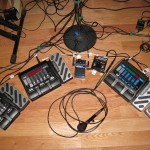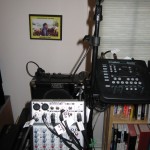
Cleaning up the stage rig: more power, less mess
I posted a little while ago about my stage setup, and noted that the audio and electrical wires were out of control and the mixer was on the floor. Well, I’ve done some work on that, and the new setup is up and running and looking a lot better, as you can see in the photos. It’s amazingly powerful and flexible, but it’s going to take some time to set up (and tear down) for performance. We’ll see how that goes at the Virginia HarmonicaFest later this month.
Here are pictures of what’s on the floor and on the mic stand now:

Lots of wires here, huh? Well, it looked worse before. Now the mixer is up off the floor, where I can operate it, and a good thing too, because there’s a lot of routing for the various devices in this setup.

Here’s how the routing works. The signal starts at my mic, which goes into the Radial Big Shot ABY pedal, where it’s routed to one or both of my RP355 and RP350. The signals from both those RPs go into a pair of channels on the mixer, and are then routed from the “control room” output on the mixer to the input of the RP255. (The signals from the RP350 and 355 do NOT go directly to the main outputs on the mixer, because I have other things in mind for them.) The output from the RP255 goes into another channel on the mixer, and is sent both to the aux send and the main out. I use the aux send and return on the mixer to send signals to and from the looper; I can control the volume of the signal returned from the looper using the aux return volume control on the mixer. Finally, the vocal mic goes into the Digitech vocalist, and from there to a mixer channel. The vocal mic can also be sent to the looper if desired.
If you look closely at the pictures, you’ll see little white tags on the ends of all the cables. Each tag carries the name of the input or output jack that the cable plugs into. That’s so I don’t get confused during setup and start plugging stuff into the wrong gazintas and gazoutas.
The mixer is mounted on the mic stand using a very small music stand designed for this purpose–that is, designed to be attached to a mic stand, if not to hold a mixer. It’s just big enough to hold the mixer, which I’ve attached to the music stand with industrial-strength velcro. I also put velcro on the mixer and the mic stand to hold the two together, but that’s not currently working brilliantly. So a little more work is needed to make sure the mixer is thoroughly secured to the mic stand.
Other than that, I think we got a winner here. I can route just about any signal from any device to any destination, and I’ve got control over every device from a mixer that’s right in front of me. I’m practicing with this setup every day, and I’m expecting to blow some minds in Virigina. Stay tuned.
Related Posts
Leave a Reply
You must be logged in to post a comment.
WHAT’S NEW
Categories
- Audio/Video
- Blog
- Blue Future
- Digitech RP Tricks and Tips
- Discography, CDs, Projects, Info, Notes
- Featured Video
- For the Beginner
- Gallery
- Hunter's Effects
- Hunter's Music
- Huntersounds for Fender Mustang
- Meet the Pros
- More Video
- MPH: Maw/Preston/Hunter
- My Three Big Contributions
- Player's Resources
- Pro Tips & Techniques
- Recommended Artists & Recordings
- Recommended Gear
- Recorded Performances
- Reviews, Interviews, Testimonials
- The Lucky One
- Uncategorized
- Upcoming Performances
- Zoom G3 Tips and Tricks
